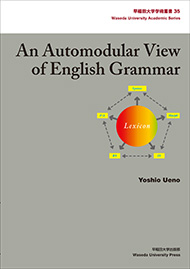
ホーム > English Titles, 新刊案内, 早稲田大学学術叢書, 書評に出た本・受賞した本 > An Automodular View of English Grammar
 |
An Automodular View of English Grammar is a far-reaching extension of Jerry Sadock’s (2012) Modular Architecture of Grammar, Cambridge University Press, and presents a multi-modular view of English syntax. It covers major syntactic phenomena of English such as passivization, raising, control, and unbounded dependencies. The automodular grammar consists of the lexicon and the five autonomous modules, which are each formalized as phrase structure grammar with their own primitives and are connected by the lexicon and the default correspondences between them.
2015年度日本英語学会賞受賞。
「上野氏の著書は、Automodular Grammar の枠組みで、英語の統語現象を包括的に扱った初めての本格的な研究書です。(中略)多岐にわたる統語現象を扱うスコープの広さとそれぞれの現象についての議論の精緻さから、その完成度が高く評価され、他の理論的枠組みにも大きな影響を与えうる労作として、本学会の学会賞にふさわしいと判断されました。」(「日本英語学会ニューズレター」2016年2月23日)
「シカゴ大学の J. Sadock が主唱する Automodular Grammar (AMG)に基づいて英語の主要現象を包括的に扱った力作である。」中島平三(『英語年鑑 <2015年版>』)
Excerpts from the Foreword
An Automodular View of English Grammar is an impressively careful, farranging,
and original contribution to the study of modular grammar. It contains
lessons that would be valuable to any linguistic researcher and it deserves a wide
audience.
Jerrold M. Sadock
The Glen A. Lloyd Distinguished Service
Professor Emeritus in the Department of Linguistics
at the University of Chicago
Foreword by Jerrold M. Sadock
Preface
Introduction
About this book
1 Modules
1.1 Morphology and Morphophonology Overview
1.1.1 Morphology
1.1.2 Morphophonology
1.2 Syntax Overview
1.3 Semantics 1: Function-Argument Structure Overview
1.4 Semantics 2: Role Structure Overview
1.5 Information Structure Overview
1.6 Lexical Items and Lexical Entries
2 Clause Structures
2.1 Inversion
2.2 Propositional Negation by not
2.3 Negative Inversion
2.4 Dummy there
2.5 Clausal Subject
2.6 Locative Inversion
2.7 Extraposition
3 Passive
3.1 Agentless Passives of Transitive Verbs
3.1.1 The syntax, F/A, and RS of agentless passives
3.1.2 Passive Lexical Rule
3.1.3 Middle Lexical Rule
3.2 Exploration of Unassociable Roles
3.3 Passive by-Phrase
3.3.1 The syntax, F/A, and RS of passive by-phrase
3.3.2 Propositional agentive phrase
3.4 Prepositional Passives
3.4.1 Prepositional Passive Lexical Rule
3.4.2 Extending the coverage of Prepositional Passive
Lexical Rule
3.4.3 On the notions of agent and patient
3.5 Verb Classes and Their Passives
3.5.1 The verb class of express
3.5.2 The verb class of suppose
3.5.3 The verb class of depend
3.5.4 The verb class of hope
3.5.5 The verb class of wonder
3.5.6 The verb class of rain
3.6 VP Idioms and Their Passives
3.7 Double Passives
3.8 Locative Inversion in the Passive
3.9 Imperatives in the Passive
3.10 The Acceptability of Passive Sentences
3.11 The Family of Passive Lexical Rules
4 Raising and Control
4.1 Subject Raising
4.1.1 Subject raising as innocuous mismatch
4.1.2 The distribution of the dummy it
4.1.3 Subject raising and EQNP
4.1.4 Subject raising in the inversion constructions
4.1.5 Subject raising and idiom chunks
4.1.6 The subject raising verb strike
4.1.7 Subject raising in the imperative
4.1.8 Subject raising in coordination
4.2 Object Raising
4.2.1 Traditional analyses of object raising
4.2.2 AMG analysis of object raising
4.2.3 Passivization of object raising verbs
4.2.4 Dummy NPs and idiom chunks in object raising
4.2.5 Characterizing raising predicates
4.2.6 Evidence for the ternary branching VP
4.3 Event Hierarchy and Control
4.3.1 Event Hierarchy
4.3.2 The control construction
4.4 Unique Control
4.4.1 Unique control verbs of order and promise
4.4.2 Notes on determining the controller
4.5 On the Controlled Argument RHO
4.6 Passivization of Unique Control Verbs
4.6.1 Passivization of object-control verbs
4.6.2 Passivization of subject control verbs
4.6.3 Impersonal passive with VP[to]
4.7 Causative Coercion
4.7.1 Need for causative coercion
4.7.2 More examples of causative coercion
4.8 Controller Shift
4.8.1 Controller shift and its triggering factors
4.8.2 Passivization of promise: revisited
4.8.3 Other pragmatic and semantic factors
4.9 Partial Control
5 Quantification
5.1 Internal Structure of Proposition
5.2 NP with Multiple Quantifiers
5.3 Quantifiers and Bound Variables
5.4 Set Arguments and Set Variables
5.5 Domain Expressions and Split Antecedents
5.6 Quantifier-Float
6 Unbounded Dependency
6.1 Wh-Questions
6.1.1 Direct wh-questions
6.1.2 ATB “wh-movement”
6.1.3 Unbounded dependency and islands
6.1.4 F/A dominance path condition and role sharing
6.1.5 WH[Q] and preposition stranding
6.1.6 Multiple wh-questions
6.1.7 Lexical entries
6.1.8 Crossover phenomena and presuppositions
6.1.9 Quiz questions
6.1.10 Nonbridge verbs
6.1.11 The Coordinate Structure Constraint revisited
6.2 Relative Clauses
6.2.1 The WH[R] feature and its percolation
6.2.2 Relative pronouns
6.2.3 Restrictive wh-relative clauses
6.2.4 Nonrestrictive relative clauses
6.2.5 That-relatives and bare relatives
6.2.6 Infinitival wh-questions and relative clauses
6.2.7 Reduced relative clauses
6.2.8 Restrictive relative clause constructions in inheritance hierarchy
7 Speech Acts
7.1 Speech Act Superstructure
7.2 Indirect Speech Acts
7.3 Embedded Performative Verbs
7.4 Antecedents in “Performative Clauses”
7.5 Referring to “Performative Clauses”
7.6 “Performative Clause” Modifiers
7.6.1 Style disjuncts
7.6.2 Performative adverb hereby
7.6.3 “Performative clause” modifying PPs
Appendix: List of Definitions, Features, and Rules
References
Index


